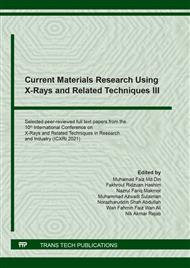[1]
J. Wood, The top ten advances in materials science, Mater. Today 11 (2008) 40–45.
Google Scholar
[2]
K.U. Kainer, Metal matrix composites: Custom-made Materials for automotive and aerospace engineering. Wiley, Weinhem, Germany, (2006).
DOI: 10.1002/3527608117
Google Scholar
[3]
A.M.S Tofail, P.E. Koumoulos, A. Bandyopadhyay, S. Bose, L. O'Donoghue, C. Charitidis, Additive manufacturing: scientific and technological challenges, market uptake and opportunities, Mater. Today 21(1) (2018) 22–37.
DOI: 10.1016/j.mattod.2017.07.001
Google Scholar
[4]
E. Ghassemieh, Materials in Automotive Application, State of the Art and Prospects. New Trends and Developments in Automotive Industry, University of Sheffield, England, (2011).
DOI: 10.5772/13286
Google Scholar
[5]
P.O. Awoyera, A. Adesina, Plastic wastes to construction products: Status, limitationsand future perspective, Case Stud. Constr. Mater. 12 (2020) e00330.
DOI: 10.1016/j.cscm.2020.e00330
Google Scholar
[6]
A. Sajwani, Y. Nielsen, The Application of the Environmental Management System at the Aluminum Industry in UAE, Int. J. GEOMATE 12 (2017) 1–10.
DOI: 10.21660/2017.30.80102
Google Scholar
[7]
N.F.M. Joharudin, N.A. Latif, M.S. Mustapa, N.A. Badarulzaman, Effects of Untreated and Treated Rice Husk Ash (RHA) Addition on Physical Propertties of Recycled Aluminium Chip AA7075, Int. J. Integr. Eng. 12 (2020) 132–137.
DOI: 10.37934/arfmts.68.1.125132
Google Scholar
[8]
M.N.N. Khan, M. Jamil, A.B.M.A. Kaish, M.F.M. Zain, An Overview on Manufacturing of Rice Husk Ash as Supplementary Cementations Material, Aust. J. Basic. Appl. Sci. 8 (2014) 176–181.
Google Scholar
[9]
N.F.M. Joharudin, N.A. Latif, M.S. Mustapa, N.A. Badarulzaman, M.F. Mahmood, Effect of Burning Temperature on Rice Husk Silica as Reinforcement of Recycled Aluminium Chip AA7075, J. Adv. Res. Fluid Mech. Therm. Sci. 68 (2020) 125–132.
DOI: 10.37934/arfmts.68.1.125132
Google Scholar
[10]
D. Koteswara Rao, Stabilization of Expensive Soil with Rice Husk Ash, Lime and Gypsum–An Experimental Study, Int. J. Eng. Sci. Technol. 3 (2012) 8076–8086.
Google Scholar
[11]
M. Rozainee, S.P. Ngo, A.A. Salema, K.G. Tan, M. Ariffin, Z.N. Zainura, Effect of Fluidising Velocity on the Combustion of Rice Husk in a Bench-scale Fluidised Bed Combustor for the Production of Amorphous Rice Husk Ash, Bioresour. Technol. 99 (2008) 703–713.
DOI: 10.1016/j.biortech.2007.01.049
Google Scholar
[12]
A.S. Mahdi, M.S. Mustapa, M.A. Lajis, M.W. Abd Rashid. The effect of cold compacting parameters for producing recycles aluminium by milling process. ARPN J. Eng. Appl. Sci. 11 (2016) 6465–6471.
Google Scholar
[13]
K.K. Alaneme, P.A. Olubambi, Corrosion and wear behaviour of rice husk ash–alumina reinforced Al-Mg-Si alloy matrix hybrid composites, J. Mater. Res. Technol. 2 (2013) 188–194.
DOI: 10.1016/j.jmrt.2013.02.005
Google Scholar
[14]
T. Srikant, M.K. Pradhan, Effect of rice husk ash on properties of aluminium alloys: A review, Mater. Today: Proc. 4 (2017) 486–495.
DOI: 10.1016/j.matpr.2017.01.049
Google Scholar
[15]
M.S. Mustapa, N. Abdul Latif, N.F. Mohd Joharudin, S. Mahzan, M.I. Mohd Masirin, N. Abdul Hamid, The Effect of Heat Treatment on Compression Strength of Recycled AA6061 Aluminium Chips, Mater. Sci. Forum 934 (2018) 124–128.
DOI: 10.4028/www.scientific.net/msf.934.124
Google Scholar
[16]
N.F.M. Joharudin, N.A. Latif, M.S. Mustapa, N.A. Badarulzaman, M.F. Mahmood, Physical Properties and Hardness of Treated Amorphous Silica as Reinforcement of AA7075 Recycled Aluminum Chip. IOP Conf. Ser.: Mater. Sci. Eng. 824 (2020) 012015.
DOI: 10.1088/1757-899x/824/1/012015
Google Scholar
[17]
H.R. Hafizpour, M. Sanjari, A. Simchi, Analysis of the effect of reinforcement particles on the compressibility of Al-SiC composite powders using a neutral network model, Mater. Des. 30 (2009) 1518–1523.
DOI: 10.1016/j.matdes.2008.07.052
Google Scholar
[18]
T.W. Kim, Determination of densification behaviour of Al-SiC metal matrix composites during consolidation processes, Mater. Sci. Eng. A 483 (2008) 648–651.
DOI: 10.1016/j.msea.2006.09.175
Google Scholar


